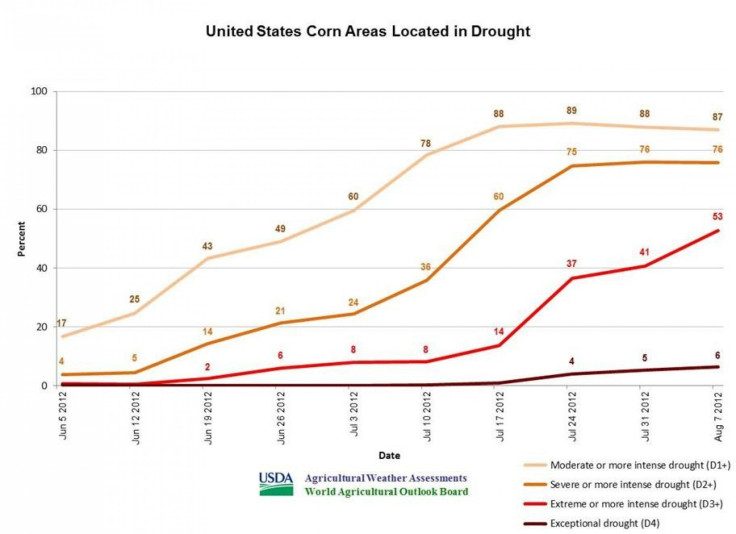Low Yields and Drought Cause Corn Prices To Surge

For an idea of the intensity of the U.S. drought, consider this: According to Thursday's weekly drought monitor report, Iowa, the largest state grower of corn and soy, has seen the amount of its territory under extreme drought conditions rise from almost 31 percent last week to nearly 70 percent since Tuesday.
While overall the 48 contiguous states saw roughly a 1 percent decline in territory affected by the drought, the most-affected areas are getting worse. Almost 87 percent of the nation's corn crops and 85 percent of soybean fields are located in the most drought-afflicted regions, according to the U.S. National Oceanic and Atmospheric Administration (NOAA).
Hayfields experiencing extreme to exceptional drought conditions nearly tripled to 31 percent of the total between July 17 and Aug. 7, while seven out of 10 heads of cattle are residing in drought-afflicted areas in the Midwest.
About the only good news: Since Tuesday the region has received some rainfall and a respite from high temperatures. It's too late for corn, but it might offer some help for soybeans.
"Cool air is trailing the rain into the Corn Belt, and below-normal Midwestern temperatures can be expected to continue into early next week," said the USDA in a statement Thursday. "Currently, dry weather has returned to the western Corn Belt, but showers will linger through Friday in the eastern Corn Belt.
"Disastrous," is how grain analyst Terry Roggensack of the Hightower Report described the situation, according to the CME (Chicago Mercantile Exchange) Group.
A Reuters poll estimates corn yields to drop to a 15-year low of about 127 bushels.
"The trade in general is underestimating the intensity of the heat and the extra intensity of moisture stress in the Midwest during the month of July," Roggensack said, according to CME Group.
July was the warmest on record at NOAA, and NASA scientists are now convinced that global warming is the reason.
In anticipation of lower yield estimated, corn futures were up 8 to 9 cents Thursday and corn for December touched an all-time high of $8.29. Soybean futures also rose sharply after the USDA announced sales to China, the largest consumer of the oilseed.
Friday's USDA report will be the first one since the drought commenced that will be based on field surveys and not statistical models.
© Copyright IBTimes 2024. All rights reserved.





















